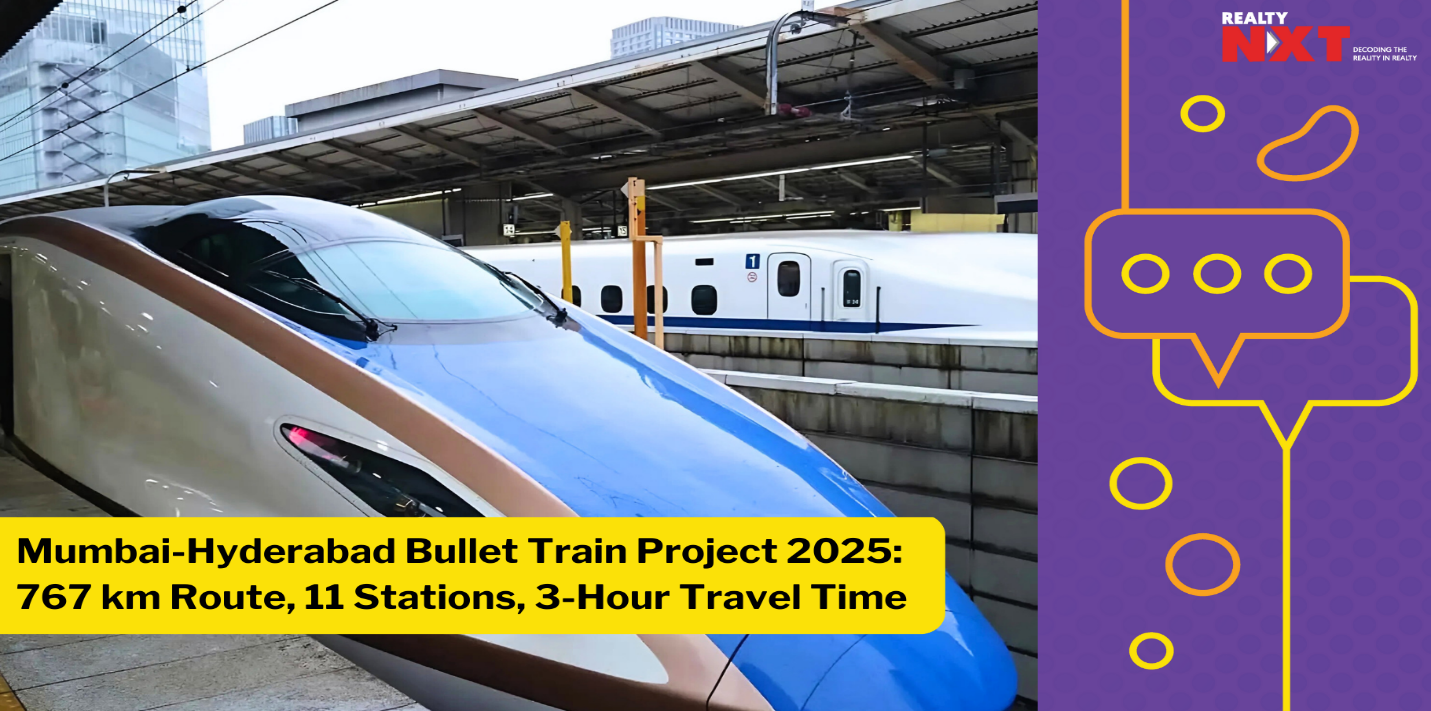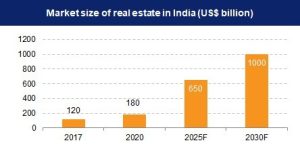India’s dream of introducing high-speed bullet trains has gradually started to take shape with the Mumbai–Ahmedabad corridor paving the way. But while that project grabs most headlines, another equally promising one is silently gaining momentum — the Mumbai Hyderabad Bullet Train. Designed to connect two of India’s most powerful metro cities, this proposed high-speed corridor aims to redefine long-distance travel across Western and Southern India.
Once operational, the Mumbai to Hyderabad bullet train will significantly reduce travel time between the two cities — from the current 14-15 hours by conventional trains or 9-10 hours by road to an estimated 3.5 to 4 hours. Beyond speed, it will also mark a new era of connectivity, boosting trade, tourism, employment, and urban development along its route.
In this blog, let’s take a deep dive into every detail — from the proposed route and station list to land acquisition, survey maps, and completion timeline — along with the latest news for 2025 surrounding the project.
Also Read:- Property Boom Around Jewar Airport: Best Areas to Watch Now
What is the Mumbai Hyderabad Bullet Train Project All About?
The Mumbai–Hyderabad Bullet Train is a proposed high-speed rail corridor being planned under the National High-Speed Rail Corporation Limited (NHSRCL). The project aims to connect Mumbai, the financial capital of India, with Hyderabad, the IT and tech capital of South India, through a corridor expected to stretch between 711 to 767 kilometers.
The train will run on Shinkansen E5 technology, similar to Japan’s bullet trains, and is expected to reach speeds of up to 320 km/h. Once completed, the line will not only enhance intercity travel but will also act as a backbone for regional economic growth, linking several major districts across Maharashtra, Karnataka, and Telangana.
The bullet train Hyderabad to Mumbai route will serve as a critical link between the western and southern parts of India, making it one of the country’s most strategically significant infrastructure projects.
Also Read:- Mumbai Vs. Bangalore Which is Better to Live
What is the Proposed Mumbai Hyderabad Bullet Train Route?

The proposed Mumbai Hyderabad bullet train route will start from Mumbai’s Bandra-Kurla Complex (BKC) — which is also the starting point of the Mumbai-Ahmedabad corridor — and end at Hyderabad, most likely near the Shamshabad region close to the Rajiv Gandhi International Airport.
Proposed Route Alignment (Indicative)
The bullet train is expected to pass through key locations such as:
- Bandra Kurla Complex (Mumbai)
- Thane / Navi Mumbai
- Lonavala
- Pune
- Daund
- Pandharpur
- Solapur
- Kalaburagi (Gulbarga)
- Zaheerabad
- Hyderabad (Terminus)
The Mumbai-Hyderabad bullet train route will traverse through two states — Maharashtra and Telangana — with a brief portion potentially crossing Karnataka’s border near Kalaburagi. The majority of the track will be elevated, while certain sections near densely populated areas might go underground to avoid land conflicts and minimize environmental disruption.
Also Read:- Why Jaipur Is Called the Pink City in India: History and Legends
Which Villages Fall Under the Mumbai-Hyderabad Bullet Train Corridor?

A major talking point during early planning has been the Mumbai-Hyderabad bullet train village list — essentially areas that would come under survey and land acquisition. As per the preliminary alignment, villages across Thane, Pune, Solapur, Osmanabad, and Kalaburagi districts in Maharashtra and Karnataka are being surveyed. In Telangana, villages across Zaheerabad and Hyderabad districts are part of the alignment review.
While the final list will be declared after DPR (Detailed Project Report) approval, early estimates suggest that over 250–300 villages might be directly or indirectly affected, depending on route finalization and structural design.
Also Read:- Best Low Cost Normal Front Elevation Designs for House in 2025-26
How Far Has the Land Acquisition Progressed?

The Mumbai-Hyderabad bullet train land acquisition is still in its initial survey and data collection stage. The NHSRCL has been conducting ground-level studies to determine the most feasible alignment that minimizes displacement and cost.
Land acquisition will likely begin only after the Detailed Project Report (DPR) is finalized and approved by both the Maharashtra and Telangana governments. Officials are reportedly focusing on identifying government-owned lands, barren tracts, and railway corridors to avoid resistance from local populations.
Since lessons from the Mumbai-Ahmedabad project have shown how land acquisition can delay progress, authorities are now working on a more community-inclusive and compensation-driven approach.
Also Read:- Interior Budgeting 2025: 1BHK/2BHK/3BHK Cost Breakdowns
What Does the Mumbai to Hyderabad Bullet Train Survey Map Reveal?
The Mumbai to Hyderabad bullet train survey map showcases a proposed corridor that roughly follows the Mumbai–Pune–Solapur–Kalaburagi–Hyderabad axis. The line is expected to run parallel to the existing Mumbai–Pune Expressway and further along NH-65 (Mumbai-Hyderabad Highway) in some stretches.
This alignment has been chosen strategically to connect major industrial belts, economic hubs, and urban centers — ensuring high ridership potential while also supporting regional development.
Moreover, the survey map has also identified zones suitable for station construction, depots, and maintenance yards. Proximity to expressways and airports is being prioritized for ease of multimodal integration.
What is the Mumbai-Hyderabad Bullet Train Completion Date?

Now comes the most-awaited question — When will the Mumbai-Hyderabad bullet train be completed?
As of 2025, the Mumbai-Hyderabad bullet train completion date has not been officially announced because the project is still in its DPR and feasibility assessment phase. However, considering the timeframes of similar projects, it is expected that once construction begins, the project could take approximately 8 to 10 years to complete.
If all approvals are received by 2026 or 2027, then the corridor could realistically become operational by 2034–2035.
This timeline may sound distant, but when it comes to large-scale, multi-state infrastructure projects involving high-speed technology, land acquisition, environmental clearances, and cross-border coordination — such long gestation periods are expected.
Also Read:- FASTag Annual Pass for Rs 3,000 in 2025-26: Apply | Activation | Benefits & Rules
What is the Latest News About the Mumbai Hyderabad Bullet Train in 2025?
The Mumbai Hyderabad bullet train latest news 2025 indicates that the National High-Speed Rail Corporation Limited has completed initial feasibility studies and begun preparing the detailed project report (DPR). Survey teams have been mapping routes, soil testing, and analyzing cost estimates for both elevated and underground sections.
Additionally, discussions have begun with Japanese and European technology partners for funding and technical collaboration. Reports also suggest that authorities are planning inter-state coordination committees to streamline approvals between Maharashtra, Karnataka, and Telangana.
While no official construction date has been announced, progress at the planning and approval level is steady — signaling that the corridor might soon enter the pre-construction stage once clearances are granted.
Also Read:- Chennai Super Kings Owner: House | Location | Business | Net Worth
How Will the Mumbai Hyderabad Bullet Train Impact Travel and Economy?

The corridor will bring multiple benefits beyond speed:
- Massive Time Savings – A journey that currently takes over 14 hours by train could be cut to less than 4 hours.
- Enhanced Regional Connectivity – Cities like Pune, Solapur, and Kalaburagi will become more accessible and economically viable.
- Industrial Boost – Improved logistics will attract industries along the corridor, potentially leading to new manufacturing clusters.
- Tourism Growth – Quick access between Mumbai and Hyderabad can boost tourism, hospitality, and business travel.
- Employment Creation – Thousands of direct and indirect jobs will emerge during construction and operation.
What Challenges Does the Project Face?

Like all mega projects, the bullet train Hyderabad to Mumbai corridor faces several hurdles:
- Land acquisition resistance in densely populated districts.
- Environmental clearances, especially near ecologically sensitive zones.
- Funding requirements, as high-speed rail infrastructure is expensive.
- Inter-state coordination between Maharashtra, Karnataka, and Telangana.
- Technology transfer and skill development, which demand specialized training and long-term collaboration.
Despite these challenges, the project’s long-term advantages make it worth pursuing for India’s expanding mobility future.
What Are the Key Features of the Mumbai-Hyderabad Bullet Train?

Some notable highlights include:
- Speed: Up to 320 km/h
- Total length: 711–767 km
- Travel time: Around 3.5–4 hours
- Expected stations: 10–12 major stops
- Technology: Japanese E5 Shinkansen model
- Alignment type: Primarily elevated, with some underground stretches
- Operating authority: National High-Speed Rail Corporation Limited (NHSRCL)
Why Is the Project So Important for India’s Infrastructure Vision?
The Mumbai Hyderabad bullet train is not just about connecting two cities — it’s about redefining the way India travels. It aligns perfectly with India’s “Vision 2047” for modern infrastructure, sustainable urban mobility, and advanced technology integration.
By connecting Mumbai’s finance and film powerhouse with Hyderabad’s IT and pharma base, the project can stimulate trade, create job corridors, and transform Tier-II towns along its route into future growth centers.
Conclusion
The Mumbai-Hyderabad Bullet Train represents India’s ambition to match global infrastructure standards. While the road to completion might be long, its potential to change the country’s transportation dynamics is undeniable. Once operational, it will create a seamless, ultra-fast connection between Western and Southern India — merging economies, shortening distances, and rewriting the narrative of modern connectivity.
At Housiey, we believe that infrastructure projects like this not only enhance connectivity but also directly influence real estate appreciation and urban lifestyle. As new transport corridors develop, the regions around them experience massive growth in property demand and investment potential.
If you found this blog insightful, don’t miss our exclusive comparison on “Mumbai Vs Bangalore: Which Is Better to Live?” , a detailed read that helps you evaluate both cities from a lifestyle and investment perspective.
FAQs
India’s dream of introducing high-speed bullet trains has gradually started to take shape with the Mumbai–Ahmedabad corridor paving the way. But while that project grabs most headlines, another equally promising one is silently gaining momentum — the Mumbai Hyderabad Bullet Train. Designed to connect two of India’s most powerful metro cities, this proposed high-speed corridor aims to redefine long-distance travel across Western and Southern India.
Once operational, the Mumbai to Hyderabad bullet train will significantly reduce travel time between the two cities — from the current 14-15 hours by conventional trains or 9-10 hours by road to an estimated 3.5 to 4 hours. Beyond speed, it will also mark a new era of connectivity, boosting trade, tourism, employment, and urban development along its route.
In this blog, let’s take a deep dive into every detail — from the proposed route and station list to land acquisition, survey maps, and completion timeline — along with the latest news for 2025 surrounding the project.
Also Read:- Property Boom Around Jewar Airport: Best Areas to Watch Now
What is the Mumbai Hyderabad Bullet Train Project All About?
The Mumbai–Hyderabad Bullet Train is a proposed high-speed rail corridor being planned under the National High-Speed Rail Corporation Limited (NHSRCL). The project aims to connect Mumbai, the financial capital of India, with Hyderabad, the IT and tech capital of South India, through a corridor expected to stretch between 711 to 767 kilometers.
The train will run on Shinkansen E5 technology, similar to Japan’s bullet trains, and is expected to reach speeds of up to 320 km/h. Once completed, the line will not only enhance intercity travel but will also act as a backbone for regional economic growth, linking several major districts across Maharashtra, Karnataka, and Telangana.
The bullet train Hyderabad to Mumbai route will serve as a critical link between the western and southern parts of India, making it one of the country’s most strategically significant infrastructure projects.
Also Read:- Mumbai Vs. Bangalore Which is Better to Live
What is the Proposed Mumbai Hyderabad Bullet Train Route?

The proposed Mumbai Hyderabad bullet train route will start from Mumbai’s Bandra-Kurla Complex (BKC) — which is also the starting point of the Mumbai-Ahmedabad corridor — and end at Hyderabad, most likely near the Shamshabad region close to the Rajiv Gandhi International Airport.
Proposed Route Alignment (Indicative)
The bullet train is expected to pass through key locations such as:
- Bandra Kurla Complex (Mumbai)
- Thane / Navi Mumbai
- Lonavala
- Pune
- Daund
- Pandharpur
- Solapur
- Kalaburagi (Gulbarga)
- Zaheerabad
- Hyderabad (Terminus)
The Mumbai-Hyderabad bullet train route will traverse through two states — Maharashtra and Telangana — with a brief portion potentially crossing Karnataka’s border near Kalaburagi. The majority of the track will be elevated, while certain sections near densely populated areas might go underground to avoid land conflicts and minimize environmental disruption.
Also Read:- Why Jaipur Is Called the Pink City in India: History and Legends
Which Villages Fall Under the Mumbai-Hyderabad Bullet Train Corridor?

A major talking point during early planning has been the Mumbai-Hyderabad bullet train village list — essentially areas that would come under survey and land acquisition. As per the preliminary alignment, villages across Thane, Pune, Solapur, Osmanabad, and Kalaburagi districts in Maharashtra and Karnataka are being surveyed. In Telangana, villages across Zaheerabad and Hyderabad districts are part of the alignment review.
While the final list will be declared after DPR (Detailed Project Report) approval, early estimates suggest that over 250–300 villages might be directly or indirectly affected, depending on route finalization and structural design.
Also Read:- Best Low Cost Normal Front Elevation Designs for House in 2025-26
How Far Has the Land Acquisition Progressed?

The Mumbai-Hyderabad bullet train land acquisition is still in its initial survey and data collection stage. The NHSRCL has been conducting ground-level studies to determine the most feasible alignment that minimizes displacement and cost.
Land acquisition will likely begin only after the Detailed Project Report (DPR) is finalized and approved by both the Maharashtra and Telangana governments. Officials are reportedly focusing on identifying government-owned lands, barren tracts, and railway corridors to avoid resistance from local populations.
Since lessons from the Mumbai-Ahmedabad project have shown how land acquisition can delay progress, authorities are now working on a more community-inclusive and compensation-driven approach.
Also Read:- Interior Budgeting 2025: 1BHK/2BHK/3BHK Cost Breakdowns
What Does the Mumbai to Hyderabad Bullet Train Survey Map Reveal?
The Mumbai to Hyderabad bullet train survey map showcases a proposed corridor that roughly follows the Mumbai–Pune–Solapur–Kalaburagi–Hyderabad axis. The line is expected to run parallel to the existing Mumbai–Pune Expressway and further along NH-65 (Mumbai-Hyderabad Highway) in some stretches.
This alignment has been chosen strategically to connect major industrial belts, economic hubs, and urban centers — ensuring high ridership potential while also supporting regional development.
Moreover, the survey map has also identified zones suitable for station construction, depots, and maintenance yards. Proximity to expressways and airports is being prioritized for ease of multimodal integration.
What is the Mumbai-Hyderabad Bullet Train Completion Date?

Now comes the most-awaited question — When will the Mumbai-Hyderabad bullet train be completed?
As of 2025, the Mumbai-Hyderabad bullet train completion date has not been officially announced because the project is still in its DPR and feasibility assessment phase. However, considering the timeframes of similar projects, it is expected that once construction begins, the project could take approximately 8 to 10 years to complete.
If all approvals are received by 2026 or 2027, then the corridor could realistically become operational by 2034–2035.
This timeline may sound distant, but when it comes to large-scale, multi-state infrastructure projects involving high-speed technology, land acquisition, environmental clearances, and cross-border coordination — such long gestation periods are expected.
Also Read:- FASTag Annual Pass for Rs 3,000 in 2025-26: Apply | Activation | Benefits & Rules
What is the Latest News About the Mumbai Hyderabad Bullet Train in 2025?
The Mumbai Hyderabad bullet train latest news 2025 indicates that the National High-Speed Rail Corporation Limited has completed initial feasibility studies and begun preparing the detailed project report (DPR). Survey teams have been mapping routes, soil testing, and analyzing cost estimates for both elevated and underground sections.
Additionally, discussions have begun with Japanese and European technology partners for funding and technical collaboration. Reports also suggest that authorities are planning inter-state coordination committees to streamline approvals between Maharashtra, Karnataka, and Telangana.
While no official construction date has been announced, progress at the planning and approval level is steady — signaling that the corridor might soon enter the pre-construction stage once clearances are granted.
Also Read:- Chennai Super Kings Owner: House | Location | Business | Net Worth
How Will the Mumbai Hyderabad Bullet Train Impact Travel and Economy?

The corridor will bring multiple benefits beyond speed:
- Massive Time Savings – A journey that currently takes over 14 hours by train could be cut to less than 4 hours.
- Enhanced Regional Connectivity – Cities like Pune, Solapur, and Kalaburagi will become more accessible and economically viable.
- Industrial Boost – Improved logistics will attract industries along the corridor, potentially leading to new manufacturing clusters.
- Tourism Growth – Quick access between Mumbai and Hyderabad can boost tourism, hospitality, and business travel.
- Employment Creation – Thousands of direct and indirect jobs will emerge during construction and operation.
What Challenges Does the Project Face?

Like all mega projects, the bullet train Hyderabad to Mumbai corridor faces several hurdles:
- Land acquisition resistance in densely populated districts.
- Environmental clearances, especially near ecologically sensitive zones.
- Funding requirements, as high-speed rail infrastructure is expensive.
- Inter-state coordination between Maharashtra, Karnataka, and Telangana.
- Technology transfer and skill development, which demand specialized training and long-term collaboration.
Despite these challenges, the project’s long-term advantages make it worth pursuing for India’s expanding mobility future.
What Are the Key Features of the Mumbai-Hyderabad Bullet Train?

Some notable highlights include:
- Speed: Up to 320 km/h
- Total length: 711–767 km
- Travel time: Around 3.5–4 hours
- Expected stations: 10–12 major stops
- Technology: Japanese E5 Shinkansen model
- Alignment type: Primarily elevated, with some underground stretches
- Operating authority: National High-Speed Rail Corporation Limited (NHSRCL)
Why Is the Project So Important for India’s Infrastructure Vision?
The Mumbai Hyderabad bullet train is not just about connecting two cities — it’s about redefining the way India travels. It aligns perfectly with India’s “Vision 2047” for modern infrastructure, sustainable urban mobility, and advanced technology integration.
By connecting Mumbai’s finance and film powerhouse with Hyderabad’s IT and pharma base, the project can stimulate trade, create job corridors, and transform Tier-II towns along its route into future growth centers.
Conclusion
The Mumbai-Hyderabad Bullet Train represents India’s ambition to match global infrastructure standards. While the road to completion might be long, its potential to change the country’s transportation dynamics is undeniable. Once operational, it will create a seamless, ultra-fast connection between Western and Southern India — merging economies, shortening distances, and rewriting the narrative of modern connectivity.
At Housiey, we believe that infrastructure projects like this not only enhance connectivity but also directly influence real estate appreciation and urban lifestyle. As new transport corridors develop, the regions around them experience massive growth in property demand and investment potential.
If you found this blog insightful, don’t miss our exclusive comparison on “Mumbai Vs Bangalore: Which Is Better to Live?” , a detailed read that helps you evaluate both cities from a lifestyle and investment perspective.
FAQs














